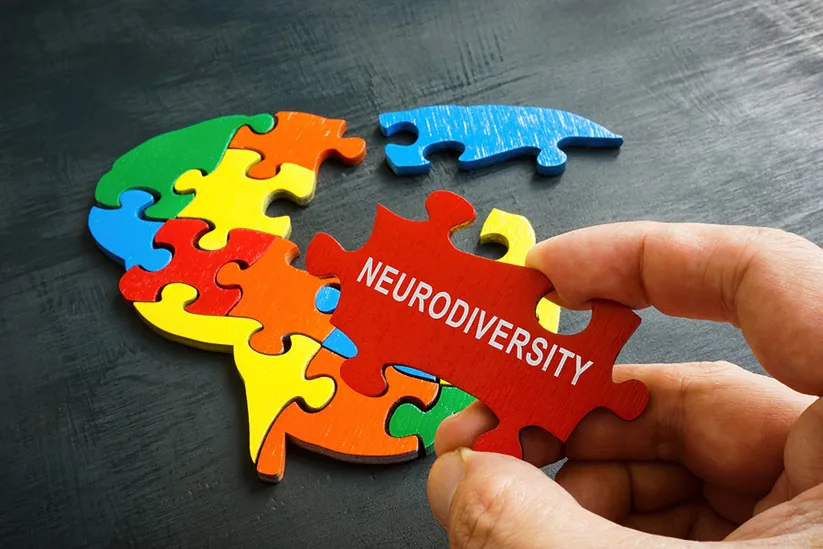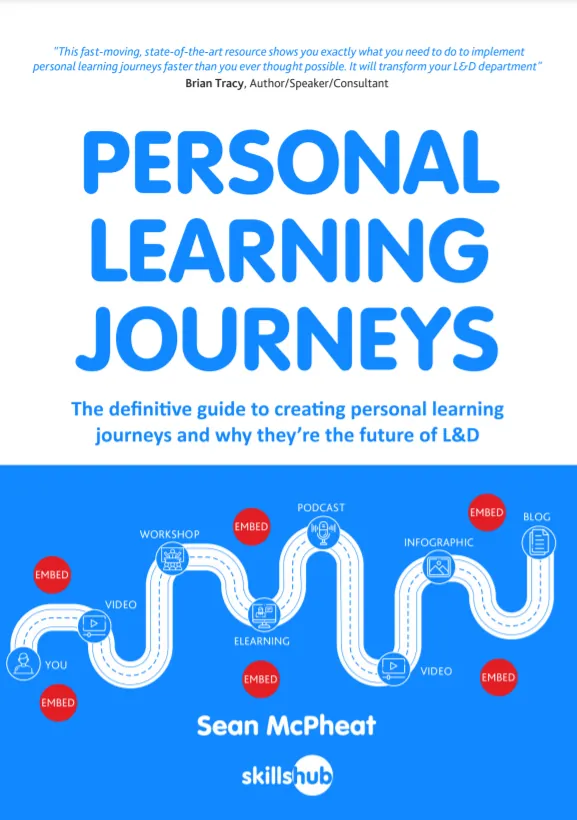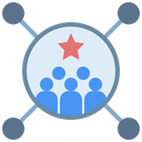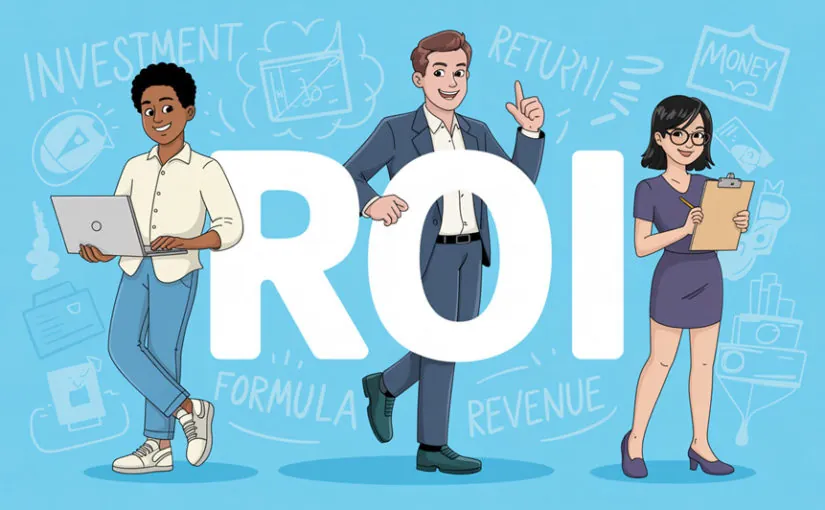
Neurodiversity in the workplace is becoming an increasingly recognised aspect of organisational diversity and inclusion.
It’s all about shedding light on the unique strengths and talents that neurodiverse individuals bring to a team.
As an eLearning company, we’ve seen an increasing number of companies seeking to enhance inclusivity in their workplaces by incorporating eLearning courses on the subject.
So, this guide delves into the essence of neurodiversity, exploring what it is, how to recognise it, and its benefits and the challenges it presents in professional settings.

Understanding Neurodiversity
In the UK, 15-20 percent of the population is neurodivergent.
But what does this even mean, and what are the different ways in which someone can be neurodiverse?
Neurodiversity Meaning and Definition
The standard neurodiversity definition is an umbrella term that refers to all the different ways people’s brains process information.
Neurodivergent, by the same token, describes individuals who have neurological development and functioning that differ from what is generally accepted as typical or “neurotypical.”
Terms like “neurodiversity” acknowledge the natural variations of human brains and embrace the fact that not everyone’s cognitive learning and neurological processes fit a standardised mould.
Types of Neurodiversity
Is dyslexia a neurodiversity? What about ADHD or bipolar disorder? Several different conditions fall under the neurodiversity umbrella, including the following:
- Autism, or Autism Spectrum Conditions: A complex neurodevelopmental condition that affects social interactions, communication, and behaviour.
- ADHD (Attention Deficit Hyperactivity Disorder): A neurodevelopmental condition characterised by persistent patterns of inattention, hyperactivity, and impulsivity.
- Bipolar Disorder: A mental health condition characterised by extreme mood swings or episodes of mania and depression.
- Dyscalculia: A condition that affects a person’s ability to understand and work with numbers.
- Dyslexia: A condition that affects a person’s ability to read, spell, and write.
- Dyspraxia or Developmental Coordination Disorder (DCD): A neurological condition that affects an individual’s ability to plan and coordinate physical movements.
- Obsessive-Compulsive Disorder (OCD): An anxiety disorder characterised by intrusive, repetitive thoughts (obsessions) and the performance of ritualistic behaviours or mental acts (compulsions) in response to those thoughts.
- Sensory Processing Disorder (SPD): Challenges in information processing and responding to sensory stimuli.
- Tourette Syndrome: A neurological disorder characterised by repetitive, involuntary movements and vocalisations called tics.
Is Neurodiversity a Disability?
From the neurodiversity perspective, conditions that are often labelled as “disabilities” are seen as part of the spectrum of human diversity. They are similar to differences in personality, learning styles, etc.
The concept of neurodiversity challenges traditional ideas of normalcy and pathology and encourages a more inclusive and accepting approach to the wide range of human neurological experiences.

Learn How To Create Personal Learning Journeys For FREE!
What Is Neurodiversity in the Workplace?
Neurodiversity in the workplace involves recognising and including individuals with neurological differences and neurodivergent conditions.
This approach emphasises the value and strengths that neurodivergent individuals bring to the workplace and seeks to create an environment that accommodates diverse ways of thinking and working.
Critical aspects of neurodiversity in the workplace include the following:
Inclusion and Acceptance
Rather than viewing neurodivergent conditions as disabilities that need to be fixed or accommodated, neurodiversity in the workplace emphasises embracing neurodivergent individuals as valuable contributors to the team. It promotes an inclusive culture that appreciates diverse perspectives and talents.
Accommodations and Support
Neurodiversity initiatives often involve providing appropriate accommodations and support to enable neurodivergent individuals to perform at their best. This may include flexible work arrangements, sensory-friendly environments, clear communication strategies, or other accommodations tailored to the needs of each individual.
Education and Awareness
Promoting awareness and understanding of neurodivergent conditions is crucial to creating a neurodiverse workplace. This may involve training programs for employees, managers, and leadership to enhance knowledge, reduce stigma, and create a more inclusive environment.
Recruitment and Hiring Practices
Companies with a neurodiversity focus may adopt inclusive hiring practices to actively seek out and hire neurodivergent talent. This can involve adjusting recruitment processes, providing neurodivergent candidates with the support they need during interviews, and considering alternative methods for evaluating skills.
Mentorship and Support Networks
Establishing mentorship programs and support networks within the organisation can benefit neurodivergent individuals. These initiatives provide opportunities for networking, guidance, and a sense of community.
Ongoing Communication
Regular and open communication is essential for creating a neurodiverse workplace. This includes ongoing feedback, dialogue, and adjustments to policies and practices based on the evolving needs of neurodivergent employees.
Neurodiversity in Practice
Now that you understand the importance of neurodiversity in the workplace, it’s time to talk about what it takes to make your company more friendly to neurodivergent people.
Neurodiversity Training
Neurodiversity training provides individuals and organisations with information, insights, and strategies related to neurodiversity. The goal is to promote understanding, acceptance, and inclusivity of individuals with neurodivergent conditions in various settings, including workplaces, schools, and communities.
Implementing Neurodiversity in Your Workplace
Implementing neurodiversity in the workplace requires a multipronged approach. Managers, supervisors, and other leaders must work together to adopt policies and procedures that accommodate neurodiverse employees and give them the tools they need to succeed.
Neurodiversity Coaching and Support
Organisations may also want to invest in neurodiversity coaching and support for employees.
Neurodiversity coaching is a specialised form of coaching that focuses on supporting individuals with neurodivergent conditions (autism, ADHD, dyslexia, etc.). Neurodiversity coaching aims to help individuals leverage their unique strengths, navigate challenges, and achieve personal and professional goals.


Neurodiversity Benefits and Challenges
An emphasis on neurodiversity in the workplace UK offers numerous benefits to all team members, not just those who are neurodivergent. It also presents unique challenges and obstacles.
Some of the most significant benefits and challenges to be aware of are explained below:


Benefit: Diverse Perspectives
One of the most significant advantages of neurodiversity in the workplace is that it creates an environment where different perspectives can be heard and celebrated.
Neurodivergent people tend to think differently and look at issues from different angles – angles that neurotypical people might never have thought to consider. These unique approaches allow for greater problem-solving potential and can help your organisation grow and thrive long-term.


Benefit: Increased Innovation
When you prioritise hiring neurodiverse employees, you’ll likely find that innovation increases throughout your organisation. Similar to the point made above, when you welcome people with diverse perspectives into your workplace, you can find new solutions to long-standing problems (and discover issues that you never realised were holding your business back).


Benefit: Improved Team Dynamics
Embracing neurodiversity can benefit your team in several ways.
First, it’s likely that you already have people working at your company who are neurodivergent. When you make a more concentrated effort to support neurodiverse people in your organisation, you create a more accepting environment that can improve morale and help those who may have been struggling to feel more supported.
Furthermore, everyone on your team can benefit from working with people who are different from them. By promoting neurodiversity (and providing the proper training and support for neurodivergent people), you give all your employees an opportunity to learn from one another, become more empathetic, and develop skills they might not have had opportunities to build otherwise.


Benefit: Reduced Employee Turnover
If your workplace welcomes and supports neurodiverse people, those employees will be more likely to be loyal to your company and stick with you long-term. Because a more accepting workplace benefits everyone, you will also likely find that neurotypical employees are less likely to jump ship, too.
Better employee retention rates can save your company a lot of money. They also maximise productivity and reduce the total amount of time you have to spend onboarding and training team members.


Benefit: Improved Company Reputation
People, including consumers, are more likely to think positively about an organisation that promotes neurodiversity and is accepting of people with various strengths and ways of processing information. If people view your company positively, they’ll be more likely to support you, which can improve your bottom line.
At the same time, a better reputation will also help with your recruitment efforts. If your organisation is known for being supportive of neurodivergent people, you may have an easier time attracting top talent and filling vacancies faster.


Benefit: Expanded Talent Pool
If you’re not taking steps to attract and hire neurodiverse employees at your organisation, you’re missing out on a lot of great talent.
When you commit to diversity, equity, and inclusion at your company – and include neurodiverse people in your efforts – you open up your talent pool and have an opportunity to connect with people who might not have been on your radar otherwise. These people could be the secret weapon that helps your company reach the next level and gain a competitive edge.
Challenge: Differences in Communication
Initially, neurotypical people and neurodiverse people may experience some difficulties communicating. As is the case with any new employee, it can take time for team members to get comfortable speaking with each other, sharing ideas, expressing disagreement, etc.


Challenge: Social Integration
Similarly, there may be some growing pains when neurodivergent employees attempt to socially integrate with existing employees. Social integration can be challenging whenever new employees (neurodivergent or not) enter a new workplace, but in some cases, the difficulties might be more pronounced with neurodiverse people.


Challenge: Accommodation Needs
Many neurodiverse individuals need specific accommodations to help them get their work done. These accommodations could be as simple as allowing for a more flexible schedule (which can be helpful to people with ADHD) or more complex (such as changing the office lighting for people sensitive to bright lights and other visual stimuli). These accommodations can, initially, be difficult for some employers to implement and may require a bit of creativity to find solutions that work for all parties.


Challenge: Stigmas and Misunderstandings
Neurodiverse people face a lot of stigmas and are often misunderstood. Some of these stigmas and stereotypes might seem harmless at first, but they can actually be quite damaging and prevent neurodivergent job seekers from finding and retaining work.
Employers and neurotypical employees will need to work hard to change their minds regarding common stereotypes to ensure they’re not inadvertently creating a hostile or unwelcoming work environment for neurodiverse employees.


Challenge: Need for Education and Additional Training
It’s not helpful to employers or employees to just throw neurodiverse employees into the deep end, so to speak, and hope for the best.
To ensure a smooth transition and give new team members a good chance at succeeding, it’s critical that employers take time to educate staff through neurodiversity training and invest in the appropriate training solutions for neurodiverse workers.
The need for additional education and training might seem like a hindrance at first, but its long-term benefits outweigh the upfront inconveniences and time requirements.


Promoting Neurodiversity in Your Workplace
The long-term benefits of creating a more neurodiverse workplace generally outweigh the short-term challenges.
How can you create a more inclusive environment for neurodiverse employees?
Start with the strategies and suggestions shared below:
Gain Buy-In from All Levels
Change starts at the top, regardless of your company’s size, industry, etc. It’s easier to create a genuinely inclusive environment and promote real change when you have buy-in from senior leaders.
If you’re having a hard time encouraging senior leadership to embrace neurodiversity in the workplace, share the advantages featured above and highlight the specific steps you can take to overcome potential challenges. By laying out a clear plan right from the start, you’ll show that you’re truly dedicated to making these changes work for everyone.
Hold Regular Training Sessions
Invest in neurodiversity coaching for all employees. Ideally, you’ll focus on training provided by (or at least created with input from) neurodivergent people.
By holding regular training sessions, you’re giving existing employees the tools they need to be more open and accommodating to new, neurodivergent employees.
You’re also increasing the likelihood that your new employees will feel accepted in the workplace and receive the necessary support from their colleagues to perform well and help the company achieve specific objectives.
Connect with Community Groups
When it comes to recruiting neurodivergent people and expanding your reach during the hiring process, it helps to connect and work with local groups in your community.
With a bit of research, you’ll likely find organisations dedicated to helping neurodiverse individuals find work. Consider a partnership with these groups so you can connect with new people and find qualified candidates to fill specific roles.
Expand and Improve Hiring Processes
Make sure your hiring processes and practices aren’t inadvertently excluding neurodivergent people.
For example, you may need to shift your focus during interviews to be less fixated on social cues (such as eye contact, which many neurodiverse people struggle with) and more concerned about skills and abilities.
You may also want to consider administering assessments in multiple formats (such as written and verbal) to accommodate those who may have dyslexia and struggle with reading and writing.
Be Willing to Make Accommodations
As mentioned earlier, many neurodivergent people can do their jobs perfectly well (if not better than neurotypical people) as long as they have certain accommodations.
Encourage employees to be open with the accommodations they need, and do your best to meet them whenever possible. If you’re not sure how to handle a specific request, don’t immediately shut it down. Instead, invite the employee to brainstorm and work with you to come up with a solution that benefits everyone.
Provide Flexibility
Schedule flexibility can be beneficial to neurodiverse and neurotypical employees alike.
By being less rigid with when employees need to be working (as well as where they work), you can empower your team members by allowing them to work at the times and places that are best for them. Doing this, in turn, can help you increase productivity and performance, too.
Adapt Employee Training Resources
If you’re like most employers, you probably have a one-size-fits-all employee training solution that all employees are expected to conform to. This is not uncommon, but it can be intimidating and unhelpful for neurodivergent employees. Consider neurodiversity in education and training and look for learning materials that accommodate various learning styles and abilities.
For example, you may want to use a learning management system that delivers information in multiple formats – written, video, audio, etc. These tools help everyone, whether they’re neurodivergent or not, to learn in the way that works best for them. This flexibility, in turn, can help with information retention and set employees up for long-term success.
Redefine Engagement
When you think of an engaged employee, what picture comes to mind?
Do you think of someone who makes direct eye contact, speaks up frequently during meetings, and has an easy time striking up conversations with anyone at any time?
This person could be an engaged employee. However, there are plenty of other ways to be engaged.
A neurodivergent employee may struggle with eye contact and be hesitant to speak their mind during meetings. That doesn’t mean they don’t care about their job, though, and want to contribute. They may just feel more comfortable sharing their thoughts in writing or in a one-on-one conversation.
Part of making your workplace more friendly to neurodiverse people is changing your perceptions. By shifting your idea of what it means to be engaged, you will be more supportive of all employees and create a more welcoming work environment for everyone.
Prioritise Clear Communication
Some neurodiverse people may struggle to pick up on subtle shifts in tone, facial expression, etc. They might not realise you’re being sarcastic, for example, or may not be able to interpret vague, off-the-cuff requests accurately.
To ensure all employees, but especially those who are neurodivergent, are set up for success, make an effort to be as clear and precise as possible when you speak, write, send voice messages, etc.
Remember that the more precise you can be, the easier it will be for team members to get things done correctly the first time, improving workplace productivity and helping you meet deadlines more frequently.
Create a Mentorship Program
Consider partnering new, neurodivergent employees with more senior employees.
These partnerships will give the new employee an opportunity to learn how the company works from someone who has been there for a long time (and has walked in their shoes, at least when it comes to being a new team member). They also provide the new employee with a go-to person to consult when they have questions or concerns.
Host Inclusivity Events
As your workplace diversifies, your approach to celebrations and events may need to diversify as well. Make sure you’re celebrating a wide range of holidays, such as Autism Acceptance Week or Neurodiversity Celebration Week.
When you plan events for these holidays, you show your neurodiverse employees that you value them and their contributions to the team. You also show your customers and job seekers who are considering applying to your company that you care about neurodiversity and aim to make everyone feel accepted.
Seek Feedback and Follow Neurodiverse People’s Lead
When you first begin your journey toward being more welcoming and accepting of neurodiversity, you’re going to make some mistakes. That’s okay. The key is to be open to learning – especially from neurodiverse employees. Seek feedback regularly from neurodiverse team members and look for opportunities to improve.
Remember, too, that it often takes a lot of courage to provide feedback and offer suggestions. If someone comes to you with recommendations or constructive criticism, resist the urge to take it personally and get offended. Instead, listen actively and strive to make positive changes whenever you can.
Conclusion
Embracing neurodiversity and building relationships is critical to a positive work environment and culture.
The right tools, including an eLearning platform, can play a significant role in your neurodiversity awareness training and make training materials more accessible to a larger audience.
That’s why we offer bespoke eLearning and off-the-shelf eLearning content solutions, as well as virtual training resources.
Get in touch today to discuss.

















